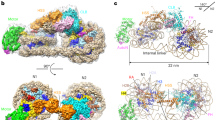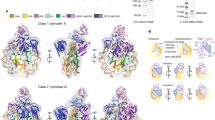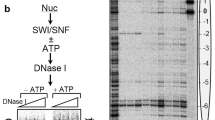Abstract
The evolutionarily conserved Swi3p, Rsc8p and Moira (SWIRM) domain is found in many chromosomal proteins involved in chromatin modifications or remodeling. Here we report the three-dimensional solution structure of the SWIRM domain from the human transcriptional adaptor ADA2α. The structure reveals a five-helix bundle consisting of two helix-turn-helix motifs connected by a central long helix, reminiscent of the histone fold. Using structural and biochemical analyses, we showed that the SWIRM domains of human ADA2α and SMARC2 bind to double-stranded and nucleosomal DNA, and we identified amino acid residues required for this function. We demonstrated that the ADA2α SWIRM domain is colocalized with lysine-acetylated histone H3 in the cell nucleus and that it potentiates the ACF remodeling activity by enhancing accessibility of nucleosomal linker DNA bound to histone H1. These data suggest a functional role of the SWIRM domain in chromatin remodeling.
This is a preview of subscription content, access via your institution
Access options
Subscribe to this journal
Receive 12 print issues and online access
$189.00 per year
only $15.75 per issue
Buy this article
- Purchase on Springer Link
- Instant access to full article PDF
Prices may be subject to local taxes which are calculated during checkout





Similar content being viewed by others
References
Workman, J.L. & Kingston, R.E. Alteration of nucleosome structure as a mechanism of transcriptional regulation. Annu. Rev. Biochem. 67, 545–579 (1998).
Carrozza, M.J., Utley, R.T., Workman, J.L. & Cote, J. The diverse functions of histone acetyltransferase complexes. Trends Genet. 19, 321–329 (2003).
Strahl, B.D. & Allis, C.D. The language of covalent histone modifications. Nature 403, 41–45 (2000).
Turner, B.M. Cellular memory and the histone code. Cell 111, 285–291 (2002).
Jenuwein, T. & Allis, C.D. Translating the histone code. Science 293, 1074–1080 (2001).
Zeng, L. & Zhou, M.M. Bromodomain: an acetyl-lysine binding domain. FEBS Lett. 513, 124–128 (2002).
Fischle, W. et al. Molecular basis for the discrimination of repressive methyl-lysine marks in histone H3 by Polycomb and HP1 chromodomains. Genes Dev. 17, 1870–1881 (2003).
Aasland, R., Stewart, A.F. & Gibson, T. The SANT domain: a putative DNA-binding domain in the SWI-SNF and ADA complexes, the transcriptional co-repressor N-CoR and TFIIIB. Trends Biochem. Sci. 21, 87–88 (1996).
Boyer, L.A., Latek, R.R. & Peterson, C.L. The SANT domain: a unique histone-tail-binding module? Nat. Rev. Mol. Cell Biol. 5, 158–163 (2004).
Stec, I., Nagl, S.B., van Ommen, G.J. & den Dunnen, J.T. The PWWP domain: a potential protein-protein interaction domain in nuclear proteins influencing differentiation? FEBS Lett. 473, 1–5 (2000).
Qiu, C., Sawada, K., Zhang, X. & Cheng, X. The PWWP domain of mammalian DNA methyltransferase Dnmt3b defines a new family of DNA-binding folds. Nat. Struct. Biol. 9, 217–224 (2002).
Ge, Y.Z. et al. Chromatin targeting of de novo DNA methyltransferases by the PWWP domain. J. Biol. Chem. 279, 25447–25454 (2004).
Aravind, L. & Iyer, L.M. The SWIRM domain: a conserved module found in chromosomal proteins points to novel chromatin-modifying activities. Genome Biol. 3, Research 0039 (2002).
Shi, Y. et al. Histone demethylation mediated by the nuclear amine oxidase homolog LSD1. Cell 119, 941–953 (2004).
Ring, H.Z., Vameghi-Meyers, V., Wang, W., Crabtree, G.R. & Francke, U. Five SWI/SNF-related, matrix-associated, actin-dependent regulator of chromatin (SMARC) genes are dispersed in the human genome. Genomics 51, 140–143 (1998).
Barlev, N.A. et al. A novel human Ada2 homologue functions with Gcn5 or Brg1 to coactivate transcription. Mol. Cell. Biol. 23, 6944–6957 (2003).
Kusch, T., Guelman, S., Abmayr, S.M. & Workman, J.L. Two Drosophila Ada2 homologues function in different multiprotein complexes. Mol. Cell. Biol. 23, 3305–3319 (2003).
Pankotai, T. et al. The homologous Drosophila transcriptional adaptors ADA2a and ADA2b are both required for normal development but have different functions. Mol. Cell. Biol. 25, 8215–8227 (2005).
Metzger, E. et al. LSD1 demethylates repressive histone marks to promote androgen-receptor-dependent transcription. Nature 437, 436–439 (2005).
Lee, M.G., Wynder, C., Cooch, N. & Shiekhattar, R. An essential role for CoREST in nucleosomal histone 3 lysine 4 demethylation. Nature 437, 432–435 (2005).
Clore, G.M. & Gronenborn, A.M. Multidimensional heteronuclear nuclear magnetic resonance of proteins. Methods Enzymol. 239, 349–363 (1994).
Kodandapani, R. et al. A new pattern for helix-turn-helix recognition revealed by the PU.1 ETS-domain-DNA complex. Nature 380, 456–460 (1996).
Zheng, N., Fraenkel, E., Pabo, C.O. & Pavletich, N.P. Structural basis of DNA recognition by the heterodimeric cell cycle transcription factor E2F-DP. Genes Dev. 13, 666–674 (1999).
Ramakrishnan, V., Finch, J.T., Graziano, V., Lee, P.L. & Sweet, R.M. Crystal structure of globular domain of histone H5 and its implications for nucleosome binding. Nature 362, 219–223 (1993).
Candau, R. et al. Identification of human proteins functionally conserved with the yeast putative adaptors ADA2 and GCN5. Mol. Cell. Biol. 16, 593–602 (1996).
Baxevanis, A.D., Arents, G., Moudrianakis, E.N. & Landsman, D. A variety of DNA-binding and multimeric proteins contain the histone fold motif. Nucleic Acids Res. 23, 2685–2691 (1995).
Sanchez, R. & Sali, A. Comparative protein structure modeling. Introduction and practical examples with modeller. Methods Mol. Biol. 143, 97–129 (2000).
Hill, D.A. & Imbalzano, A.N. Human SWI/SNF nucleosome remodeling activity is partially inhibited by linker histone H1. Biochemistry 39, 11649–11656 (2000).
Grant, P.A., Sterner, D.E., Duggan, L.J., Workman, J.L. & Berger, S.L. The SAGA unfolds: convergence of transcription regulators in chromatin-modifying complexes. Trends Cell Biol. 8, 193–197 (1998).
Ogata, K. et al. Solution structure of a specific DNA complex of the Myb DNA-binding domain with cooperative recognition helices. Cell 79, 639–648 (1994).
Wang, L., Liu, L. & Berger, S.L. Critical residues for histone acetylation by Gcn5, functioning in Ada and SAGA complexes, are also required for transcriptional function in vivo. Genes Dev. 12, 640–653 (1998).
Ito, T., Bulger, M., Pazin, M.J., Kobayashi, R. & Kadonaga, J.T. ACF, an ISWI-containing and ATP-utilizing chromatin assembly and remodeling factor. Cell 90, 145–155 (1997).
Fyodorov, D.V., Blower, M.D., Karpen, G.H. & Kadonaga, J.T. Acf1 confers unique activities to ACF/CHRAC and promotes the formation rather than disruption of chromatin in vivo. Genes Dev. 18, 170–183 (2004).
Yamazaki, T., Lee, W., Arrowsmith, C.H., Mahandiram, D.R. & Kay, L.E. A suite of triple resonance NMR experiments for the backbone assignment of 15N, 13C, 2H labeled proteins with high sensitivity. J. Am. Chem. Soc. 116, 11655–11666 (1994).
Sattler, M., Schleucher, J. & Griesinger, C. Heteronuclear multidimensional NMR experiments for the structure determination of proteins in solution employing pulsed field gradients. Prog. Nucl. Magn. Reson. Spectrosc. 34, 93–158 (1999).
Farrow, N.A. et al. Backbone dynamics of a free and phosphopeptide-complexed Src homology 2 domain studied by 15N NMR relaxation. Biochemistry 33, 5984–6003 (1994).
Brunger, A.T. X-PLOR Version 3.1: A System for X-Ray Crystallography and NMR (Yale University Press, New Haven, Connecticut, USA, 1993).
Nilges, M. & O'Donoghue, S. Ambiguous NOEs and automated NOE assignment. Prog. Nucl. Magn. Reson. Spectrosc. 32, 107–139 (1998).
Laskowski, R.A., Rullmannn, J.A., MacArthur, M.W., Kaptein, R. & Thornton, J.M. AQUA and PROCHECK-NMR: programs for checking the quality of protein structures solved by NMR. J. Biomol. NMR 8, 477–486 (1996).
Hnilica, L.S. Methods for analysis of histones. Methods Enzymol. 40, 102–138 (1975).
Noll, H. & Noll, M. Sucrose gradient techniques and applications to nucleosome structure. Methods Enzymol. 170, 55–116 (1989).
Hamiche, A., Schultz, P., Ramakrishnan, V., Oudet, P. & Prunell, A. Linker histone-dependent DNA structure in linear mononucleosomes. J. Mol. Biol. 257, 30–42 (1996).
Luger, K., Rechsteiner, T.J. & Richmond, T.J. Preparation of nucleosome core particle from recombinant histones. Methods Enzymol. 304, 3–19 (1999).
Li, S. et al. Transcriptional repression of the cystic fibrosis transmembrane conductance regulator gene, mediated by CCAAT displacement protein/cut homolog, is associated with histone deacetylation. J. Biol. Chem. 274, 7803–7815 (1999).
Fyodorov, D.V. & Kadonaga, J.T. Chromatin assembly in vitro with purified recombinant ACF and NAP-1. Methods Enzymol. 371, 499–515 (2003).
Ura, K. et al. ATP-dependent chromatin remodeling facilitates nucleotide excision repair of UV-induced DNA lesions in synthetic dinucleosomes. EMBO J. 20, 2004–2014 (2001).
Polach, K.J. & Widom, J. Restriction enzymes as probes of nucleosome stability and dynamics. Methods Enzymol. 304, 278–298 (1999).
Li, D. et al. Kruppel-like factor-6 promotes preadipocyte differentiation through histone deacetylase 3-dependent repression of DLK1. J. Biol. Chem. 280, 26941–26952 (2005).
Nishio, H. & Walsh, M.J. CCAAT displacement protein/cut homolog recruits G9a histone lysine methyltransferase to repress transcription. Proc. Natl. Acad. Sci. USA 101, 11257–11262 (2004).
Acknowledgements
The authors gratefully acknowledge M. Bauck for critical reading of the manuscript, S. Mujtaba for technical help and S. Hearn at Cold Spring Harbor Laboratory Microscopy Facility for technical assistance in performing the confocal laser scanning microscopy. This work was supported by grants from the US National Institutes of Health to M.-M.Z. and M.J.W.
Author information
Authors and Affiliations
Corresponding authors
Ethics declarations
Competing interests
The authors declare no competing financial interests.
Supplementary information
Supplementary Fig. 1
Structure-based sequence alignment of SWIRM domains. (PDF 385 kb)
Supplementary Fig. 2
Three-dimensional NMR structure of the human ADA2α SWIRM domain. (PDF 50 kb)
Supplementary Fig. 3
Assessment of the R428A mutation effect on the ADA2 SWIRM domain structure. (PDF 23 kb)
Rights and permissions
About this article
Cite this article
Qian, C., Zhang, Q., Li, S. et al. Structure and chromosomal DNA binding of the SWIRM domain. Nat Struct Mol Biol 12, 1078–1085 (2005). https://doi.org/10.1038/nsmb1022
Received:
Accepted:
Published:
Issue Date:
DOI: https://doi.org/10.1038/nsmb1022
This article is cited by
-
Dynamic changes of histone methylation in mammalian oocytes and early embryos
Histochemistry and Cell Biology (2022)
-
Epigenetic Regulation of Antibody Responses by the Histone H2A Deubiquitinase MYSM1
Scientific Reports (2015)
-
1H, 15N, and 13C Resonance Assignments and Secondary Structure of the SWIRM Domain of Human BAF155, a Chromatin Remodeling Complex Componente
Molecules and Cells (2013)
-
CCDC134 interacts with hADA2a and functions as a regulator of hADA2a in acetyltransferase activity, DNA damage-induced apoptosis and cell cycle arrest
Histochemistry and Cell Biology (2012)
-
Sgf29 binds histone H3K4me2/3 and is required for SAGA complex recruitment and histone H3 acetylation
The EMBO Journal (2011)



